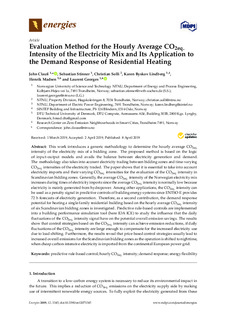| dc.contributor.author | Clauß, John | |
| dc.contributor.author | Stinner, Sebastian | |
| dc.contributor.author | Solli, Christian | |
| dc.contributor.author | Lindberg, Karen Byskov | |
| dc.contributor.author | Madsen, Henrik | |
| dc.contributor.author | Georges, Laurent | |
| dc.date.accessioned | 2019-05-23T06:46:11Z | |
| dc.date.available | 2019-05-23T06:46:11Z | |
| dc.date.created | 2019-04-25T14:48:53Z | |
| dc.date.issued | 2019 | |
| dc.identifier.citation | Energies. 2019, 12 (7), . | nb_NO |
| dc.identifier.issn | 1996-1073 | |
| dc.identifier.uri | http://hdl.handle.net/11250/2598501 | |
| dc.description.abstract | This work introduces a generic methodology to determine the hourly average CO2eq. intensity of the electricity mix of a bidding zone. The proposed method is based on the logic of input–output models and avails the balance between electricity generation and demand. The methodology also takes into account electricity trading between bidding zones and time-varying CO2eq. intensities of the electricity traded. The paper shows that it is essential to take into account electricity imports and their varying CO2eq. intensities for the evaluation of the CO2eq. intensity in Scandinavian bidding zones. Generally, the average CO2eq. intensity of the Norwegian electricity mix increases during times of electricity imports since the average CO2eq. intensity is normally low because electricity is mainly generated from hydropower. Among other applications, the CO2eq. intensity can be used as a penalty signal in predictive controls of building energy systems since ENTSO-E provides 72 h forecasts of electricity generation. Therefore, as a second contribution, the demand response potential for heating a single-family residential building based on the hourly average CO2eq. intensity of six Scandinavian bidding zones is investigated. Predictive rule-based controls are implemented into a building performance simulation tool (here IDA ICE) to study the influence that the daily fluctuations of the CO2eq. intensity signal have on the potential overall emission savings. The results show that control strategies based on the CO2eq. intensity can achieve emission reductions, if daily fluctuations of the CO2eq. intensity are large enough to compensate for the increased electricity use due to load shifting. Furthermore, the results reveal that price-based control strategies usually lead to increased overall emissions for the Scandinavian bidding zones as the operation is shifted to nighttime, when cheap carbon-intensive electricity is imported from the continental European power grid. | nb_NO |
| dc.language.iso | eng | nb_NO |
| dc.publisher | MDPI | nb_NO |
| dc.rights | Navngivelse 4.0 Internasjonal | * |
| dc.rights.uri | http://creativecommons.org/licenses/by/4.0/deed.no | * |
| dc.title | Evaluation Method for the Hourly Average CO2eq. Intensity of the Electricity Mix and Its Application to the Demand Response of Residential Heating | nb_NO |
| dc.type | Journal article | nb_NO |
| dc.type | Peer reviewed | nb_NO |
| dc.description.version | publishedVersion | nb_NO |
| dc.source.pagenumber | 25 | nb_NO |
| dc.source.volume | 12 | nb_NO |
| dc.source.journal | Energies | nb_NO |
| dc.source.issue | 7 | nb_NO |
| dc.identifier.doi | 10.3390/en12071345 | |
| dc.identifier.cristin | 1693925 | |
| dc.description.localcode | This is an open access article distributed under the Creative Commons Attribution License which permits unrestricted use, distribution, and reproduction in any medium, provided the original work is properly cited (CC BY 4.0). | nb_NO |
| cristin.unitcode | 194,64,25,0 | |
| cristin.unitcode | 194,15,0,0 | |
| cristin.unitcode | 194,63,20,0 | |
| cristin.unitname | Institutt for energi- og prosessteknikk | |
| cristin.unitname | Økonomi- og eiendomsdirektør | |
| cristin.unitname | Institutt for elkraftteknikk | |
| cristin.ispublished | true | |
| cristin.fulltext | original | |
| cristin.qualitycode | 1 | |

